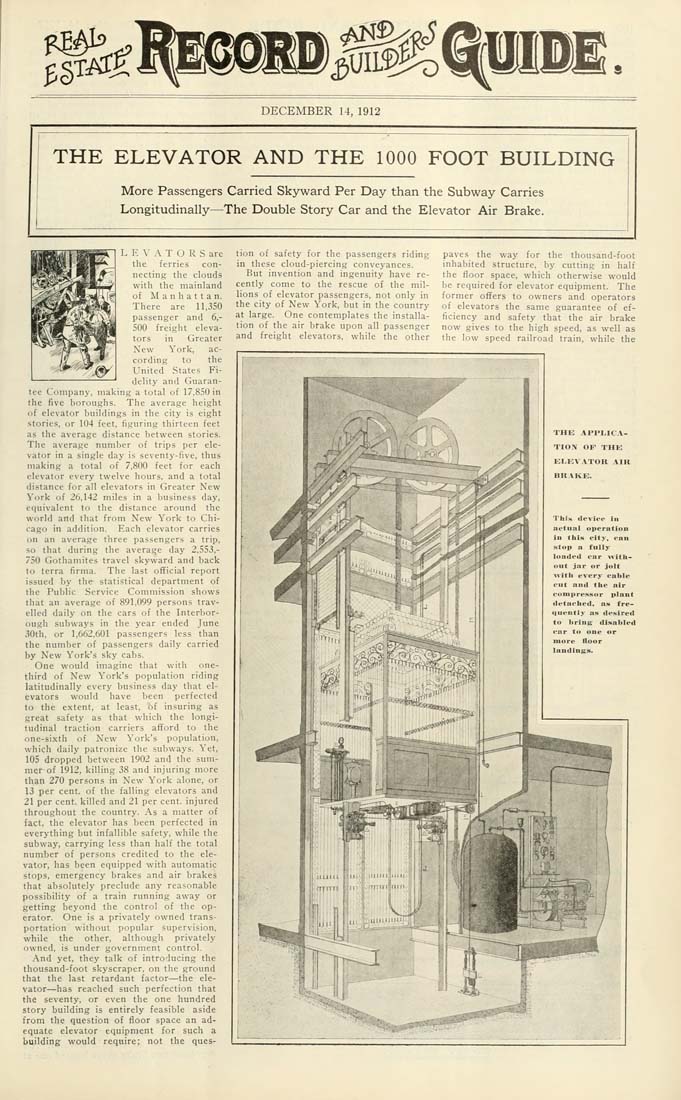Please note: this text may be incomplete. For more information about this OCR, view
About OCR text.
mm
DECEMBER 14, 1912
THE ELEVATOR AND THE 1000 FOOT BUILDING
More Passengers Carried Skyward Per Day than the Subway Carries
Longitudinally—The Double Story Car and the Elevator Air Brake.
L E \ A T O R S are
the ferries con¬
necting the clouds
with the mainland
of Manhattan.
There are 11,350
passenger and 6,-
500 freight eleva¬
tors in Greater
New York, ac¬
cording to the
United States Fi¬
delity and Guaran¬
tee Company, making a total of 17,850 in
the five boroughs. The average height
of elevator buildings in the city is eight
stories, or 104 feet, figuring thirteen feet
as the average distance between stories.
The average number of trips per ele¬
vator in a single day is seventy-five, thus
making a total of 7,800 feet for each
elevator every twelve hours, and a total
distance for all elevators in Greater New
York of 26,142 miles in a business day,
equivalent to the distance around the
world and that from New York to Chi¬
cago in addition. Each elevator carries
on an average three passengers a trip,
so that during the average day 2,553,-
750 Gothamites travel skyward and back
to terra firma. The last official report
issued by the statistical department of
the Public Service Commission shows
that an average of 891,099 persons trav¬
elled daily on the cars of the Interbor¬
ough subways in the year ended June
30th, or 1,662,601 passengers less than
the number of passengers daily carried
by New York's sky cabs.
One would imagine that with one-
third of New York's population riding
latitudinally every business day that el¬
evators would have been perfected
to the extent, at least, hi insuring as
great safety as that which the longi¬
tudinal traction carriers afford to the
one-sixth of New York's population,
which daily patronize the subways. Vet,
105 dropped between 1902 and the sum¬
mer-of 1912, killing 38 and injuring more
than 270 persons in New York alone, or
13 per cent, of the falling elevators and
21 per cent, killed and 21 per cent, injured
throughout the country. -\s a matter of
fact, the elevator has been perfected in
everything but infallible safety, while the
subway, carrying less than half the total
number of persons credited to the ele¬
vator, has been equipped with automatic
stops, emergency brakes and air brakes
that absolutely preclude any reasonable
possibility of a train running away or
getting beyond the control of the op¬
erator. One is a privately owned trans¬
portation without popular supervision,
while the other, although privately
owned, is under government control.
And yet, they talk of introducing the
thousand-foot skyscraper, on the ground
that the last retardant factor—the ele¬
vator—has reached such perfection that
the seventy, or even the one hundred
story building is entirely feasible aside
from the question of floor space an ad¬
equate elevator equipment for such a
building would require; not the ques¬
tion of safety for the passengers riding
in these cloud-piercing conveyances.
But invention and ingenuity have re¬
cently come to the rescue of the mil¬
lions of elevator passengers, not only in
the city of New York, but in the country
at large. One contemplates the installa¬
tion of the air brake upon all passenger
and freight elevators, while the other
paves the way for the thousand-foot
inhabited structure, by cutting in half
the floor space, which otherwise would
be required for elevator equipment. The
former offers to owners and operators
of elevators the same guarantee of ef¬
ficiency and safety that the air brake
now gives to the high speed, as well as
the low speed railroad train, while the
THE APPLICA¬
TION OF THE
ELEVATOR AIR
BR.VKB.
ThiN ilevice iu
actual operation
in this city, can
stop a fully
loaded car tvitb-
out jar or jolt
^^■ith every cable
cut and the air
compressor plant
detached, as fre¬
quently as desired
to bring disabled
car to one or
more floor
landings.








